William Wynford or William of Wynford (flourished 1360–1405)[1] was one of the most successful English master masons of the 14th century, using the new Perpendicular Gothic style.[2]
Life and career
He is first mentioned in 1360 when at work at Windsor Castle as warden of masons' work. He became master mason at Wells Cathedral on 1 February 1365[3] where he is believed to have designed the South West tower, it was probably here that he met William of Wykeham who was then a provost of the cathedral. He was made master of the works at Windsor Castle in 1364[4] under Wykeham, in 1372 Edward III granted Wynford a pension of £10 per annum.
In 1375–76 he was at work at Abingdon Abbey and working for the crown at Corfe Castle in 1377–78 making new rooms in the keep. In 1378 Wynford was working with Henry Yevele at Southampton.
With the death of Edward III the new king Richard II of England favoured Wykeham, with newfound wealth he founded in 1379 New College, Oxford, which was designed by Wynford,[5] who also designed Winchester College[6] founded by Wykeham in 1382.
In 1389-90 he was repairing Winchester Castle, from 1392 he designed Wardour Castle, and in the 1390s[7] he commenced his last major work, the remodelling of the Norman nave of Winchester Cathedral in the latest Perpendicular Gothic style.
Features of Wynford's works
Wynford used a distinctive plan of placing the chapel and great hall end to end; this occurred at Windsor Castle (the chapel and hall were united as a single hall by Sir Jeffry Wyatville for George IV), and at Winchester and New Colleges. The two colleges also have cloisters that are next to rather than surrounded by the main college buildings, which form a separate courtyard consisting of as well as the great hall and chapel, an entrance gate with tower above, sets of rooms for scholars and fellows opening off staircases, a library, accommodation for the Warden. The kitchen, bakery and other service buildings are in a separate wing at New College, but surround a second courtyard at Winchester College. New college also has a bell tower next to the cloister.
These were the very first educational buildings in England to be designed as a complete entity and, as such, they influenced later college buildings such as King's College, Cambridge, Eton College & Magdalen College, Oxford.
Appearance
There is a portrait of Wynford[8] in the stained glass in the east window of Winchester College; this shows an old man with thinning hair, a long nose and dropping moustache and forked beard with the words 'Willms Wynfort lathomus' below.
Gallery of architectural work
 New College, Oxford, the chapel exterior looking north-west
New College, Oxford, the chapel exterior looking north-west New College, Oxford, the chapel interior looking east
New College, Oxford, the chapel interior looking east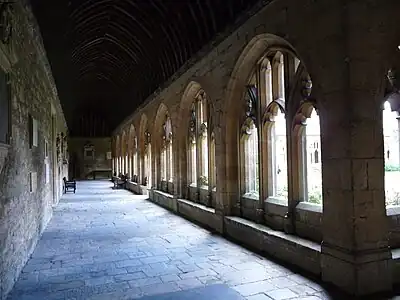 New College, Oxford, the cloisters
New College, Oxford, the cloisters Winchester College, gateway
Winchester College, gateway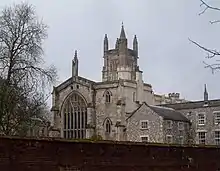 Winchester College, exterior of the chapel
Winchester College, exterior of the chapel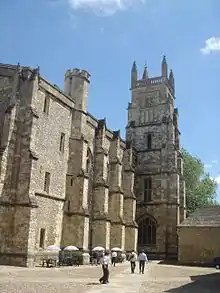 Winchester College, exterior of the chapel
Winchester College, exterior of the chapel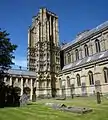 Wells Cathedral, the south-west tower
Wells Cathedral, the south-west tower Wardour Castle
Wardour Castle Wardour Castle
Wardour Castle Winchester Cathedral, west front
Winchester Cathedral, west front Winchester Cathedral, great west window in nave
Winchester Cathedral, great west window in nave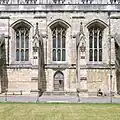 Winchester Cathedral, South nave aisle windows
Winchester Cathedral, South nave aisle windows Winchester cathedral, nave looking east
Winchester cathedral, nave looking east Winchester cathedral, nave looking west
Winchester cathedral, nave looking west Winchester cathedral, south aisle looking east
Winchester cathedral, south aisle looking east Winchester cathedral, nave vaulting
Winchester cathedral, nave vaulting
References
- ↑ Harvey, John (1954). English Medieval Architects A Biographical Dictionary Down to 1550. B. T. Batsford. p. 352.
- ↑ Curl, James Stevens; Wilson, Susan (2016). Oxford Dictionary of Architecture. Oxford University Press. p. 858. ISBN 978-0-19-967499-2.
- ↑ page 89, L.S. Colchester (Editor), Wells cathedral A History, 1982, Open Books
- ↑ Tyack, Geoffrey; Bradley, Simon; Pevsner, Nikolaus (2010). Buildings of England Berkshire. Yale University Press. p. 630. ISBN 978-0-30-012662-4.
- ↑ pages 156-164, John Buxton & Penry Williams (Editors), new College Oxford 1379–1979, 1979, Warden & Fellows of New College
- ↑ page 75, Sir William Hayter, William of Wykeham patron of the arts, 1970, Chatto & Windus
- ↑ page 218, John Crook (Editor), Winchester Cathedral Nine hundred Years 1093–1993, 1993, Pillimore & Company
- ↑ page 354, English Medieval Architects A Biographical Dictionary Down to 1550, John Harvey 1984